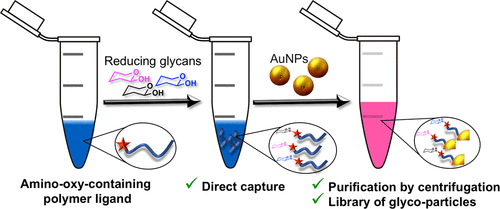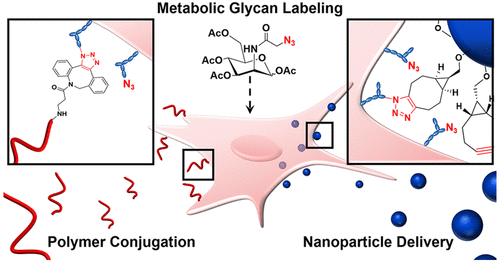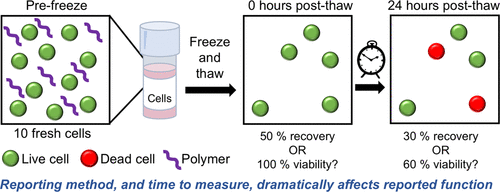Gibson Group News
Polymer/protein conjugates to engineer freeze stability is published
Proteins find application as catalysts, therapies, in food stuff and in diagnostics. However, they often require cold storage, with organic solvents used as excipients to protect them. In our latest work, we further explore the use of PVA (poly(vinyl alcohol) as an additive to control ice growth (ice recrystallisation inhibition) and hence protect proteins. Here we first explore how PVA can protect LDH (lactate dehydrogenase) which is a hard-to-freeze enzyme. We then explore whether simply mixing, or covalent attaching, the PVA to a protein gives maximal protection. Bioconjugation with PVA is hard, as it is a lesser activated monomer and it must be polymerized as vinyl acetate - the deprotection step complicates the synthetic design. Therefore we used non-site specific methods (targeting amines) to attach the PVA, in what is only the second ever report (we think) of a PVA-protein conjugate. The conjugation of the polymer provided protection at lower concentrations than simple mixing and shows that PVA might be an appealing alternative to e.g. PEGylation, as it brings advanced cryoprotectant properties.
Read the paper here
Welcome to new group member, Dr Marta Neves
Marta joined the University of Warwick and GibsonGroup as an Institute of Advanced Study WIRL-COFUND Fellow in September 2020. Marta was born in Portugal and she has a PhD in Pharmaceutical Sciences from the University of Porto (Portugal). Marta has a background in electrochemical biosensing which she acquired working across international and inter-sectorial environments. At GibsonGroup, Marta is going to study prostate cancer glycobiology and design and develop novel multiplexed biosensors to overcome limitations of current diagnostic approaches
SARS-COV-2 detection paper now published in ACS Central Science
There is an urgent, global, need for new therapeutic, vaccine and diagnostic interventions to address the COVID-19 challenge. Current diagnostics are mostly based upon PCR (polymerase chain reaction) methods where the genetic material of the SARS-COV-2 virus is isolated and sequenced. A challenge with this method is that significant infrastructure and trained personnel are needed, and the results are not instant. In this work, conducted in collaboration with Iceni Diagnostics (and MANY UoW colleagues) we hijacked a pregnancy test set up, to enable rapid detection. Crucial to this was the identification that sialic acids (a type of cell-surface glycan) bind the SARS-COV_2 spike protein. By incorporating sialic acids onto the ends of polymers, immobilized onto gold nanoparticles we made a paper-based tool, enabling rapid detection of the spike protein, a virus mimic and also a virus engineered to 'look like' SARS-COV-2. This method may enable ultra rapid and low cost screening to identify individuals who carry the virus, to triage for the PCR testing. We are actively pursuing the development of this technology.
Read the paper here
Synthesis of glyconanoparticles without protecting groups, published in Bioconjugate Chemistry
Glycans (sugars) dictate a huge range of biological processes, from host-pathogen interactions to cell-cell communication. We have a large research 
program into using nanomaterials to display glycans, mimicking how they are presented on cell surfaces. For example, we have used these in diagnostics (including our recent work on rapid COVID diagnostics). However a key challenge is actually getting the glycans on the nanoparticles as multiple protecting groups are often needed. In our latest paper, we installed amino-oxy groups at the end-group of polymers to allow capture of reducing glycans in aqueous solution, with the aim of simplifying our synthetic route with our long-term aim of fully-automating the process. We critically evaluated the efficiency of this reaction using 13-C enriched glucose, to enable the actual polymer, rather than model small molecules to be used. This show 25 % of the chains can capture a glycan, which was then immobilised onto gold nanoparticles. This approach is particularly suited to screening applications where small amounts of glycan are available, to identify hits.
Read the paper here
Protecting Group Free Synthesis of Glyconanoparticles Using Aminooxy-Terminated Polymer Ligands
Cryopreserving Stem Cells with our Polymeric Cryoprotectants Published in ACS Applied Biomaterials
 Cryopreservation (freezing) of cells is essential to allow them to be stored and transported. This is especially crucial for emerging stem-cell therapies (i.e. where stem cells are injected into patients, or as part of a biomaterial) where getting the cells from the processing facility to the patient intact, is crucial for a successful therapeutic outcome. In this work, we explored how our new macromolecular cryoprotectants (based on polyampholytes) can be used to reduce the amount of DMSO (dimethyl sulphoxide) required to cryopreserve stems cells, with a focus on retaining their 'function'. We show that we can reduce the DMSO from 10 wt % to 2.5 wt % by adding in our polymers. This decrease in DMSO could be therapeutically useful to reduce side-effects and to simplify processing (due to less DMSO in the mixture post-thaw creating more flexibility in how the cells can be handled). The cells were shown to retain their differentiation ('become other cell types') capability to the same extent as DMSO-alone methods.
Cryopreservation (freezing) of cells is essential to allow them to be stored and transported. This is especially crucial for emerging stem-cell therapies (i.e. where stem cells are injected into patients, or as part of a biomaterial) where getting the cells from the processing facility to the patient intact, is crucial for a successful therapeutic outcome. In this work, we explored how our new macromolecular cryoprotectants (based on polyampholytes) can be used to reduce the amount of DMSO (dimethyl sulphoxide) required to cryopreserve stems cells, with a focus on retaining their 'function'. We show that we can reduce the DMSO from 10 wt % to 2.5 wt % by adding in our polymers. This decrease in DMSO could be therapeutically useful to reduce side-effects and to simplify processing (due to less DMSO in the mixture post-thaw creating more flexibility in how the cells can be handled). The cells were shown to retain their differentiation ('become other cell types') capability to the same extent as DMSO-alone methods.
This is part of our large research program into innovative cryoprotectants to make cell based therapies and diagnostics cheaper, easier and more readily available.
Read the work here
Low DMSO Cryopreservation of Stem Cells Enabled by Macromolecular Cryoprotectants
Viewpoint article on engineering cell surfaces published in ACS Macroletters
 Engineering cell surfaces is not trivial. In Nature gene regulation controls protein expression, but we are interested in non-genetic tools to introduce new functionality to cell surfaces, specifically synthetic polymers. In this viewpoint we summarize how the technique of metabolic glycan labeling is being used in polymer/nanoscience to introduce non-natural functionality to cell surfaces. Metabolic glycan labeling allows the introduction of bio-orthogonal handles (e.g. azides) to cells by hijacking glycan biosynthesis pathways by addition of e.g. Azido-N-acetyl mannosamine derivatives, which is processed into sialic acid on the cell surface. This azide (or other functionality) can be used to recruit polymers to the cell surface by formation of a covalent bond. In this article we highlight this really exciting area of biomaterials and summarises some applications including cell-tracking, studying cell-cell communication and more.
Engineering cell surfaces is not trivial. In Nature gene regulation controls protein expression, but we are interested in non-genetic tools to introduce new functionality to cell surfaces, specifically synthetic polymers. In this viewpoint we summarize how the technique of metabolic glycan labeling is being used in polymer/nanoscience to introduce non-natural functionality to cell surfaces. Metabolic glycan labeling allows the introduction of bio-orthogonal handles (e.g. azides) to cells by hijacking glycan biosynthesis pathways by addition of e.g. Azido-N-acetyl mannosamine derivatives, which is processed into sialic acid on the cell surface. This azide (or other functionality) can be used to recruit polymers to the cell surface by formation of a covalent bond. In this article we highlight this really exciting area of biomaterials and summarises some applications including cell-tracking, studying cell-cell communication and more.
This article is part of the 100th Anniversary of Macromolecular Science series.
The Gibson Group is featured on BBC News
On Thursday 25th November, members of our team were interviewed by BBC midlands science correspondent David Gregory. This feature, which was the lead story on BBC Midlands TV news, discussed the teams effort to develop a faster, cheaper and easier to use coronavirus diagnostic. The team are making rapid progress and you can read the story here.
Our latest work on macromolecular cryoprotectants has been published in Biomacromolecules
 There is increasing interest in developing new macromolecular cryoprotectants to improve cryopreservation outcomes, however, the criteria used for assessing cryopreservation success varies greatly between studies. In this work we critically analysed the impact of different macromolecular cryoprotectants on post-thaw cell viability and cell recovery, at multiple timepoints, for several cell lines. We found that cell viability was not a good predictor of cryopreservation outcome as it overlooked the number of cells lost during the cryopreservation process. In addition, we showed that it is essential to culture the cells for a period after thawing to allow apoptosis (programmed cell death) to initiate and complete. Considering these findings, we demonstrated that polyampholytes (an emerging class of macromolecular cryoprotectant) are effective cryoprotectants that improve both cell viability and cell recovery, compared to poly(ethylene glycol) which can produce in false positive results.
There is increasing interest in developing new macromolecular cryoprotectants to improve cryopreservation outcomes, however, the criteria used for assessing cryopreservation success varies greatly between studies. In this work we critically analysed the impact of different macromolecular cryoprotectants on post-thaw cell viability and cell recovery, at multiple timepoints, for several cell lines. We found that cell viability was not a good predictor of cryopreservation outcome as it overlooked the number of cells lost during the cryopreservation process. In addition, we showed that it is essential to culture the cells for a period after thawing to allow apoptosis (programmed cell death) to initiate and complete. Considering these findings, we demonstrated that polyampholytes (an emerging class of macromolecular cryoprotectant) are effective cryoprotectants that improve both cell viability and cell recovery, compared to poly(ethylene glycol) which can produce in false positive results.
Read the paper here:
